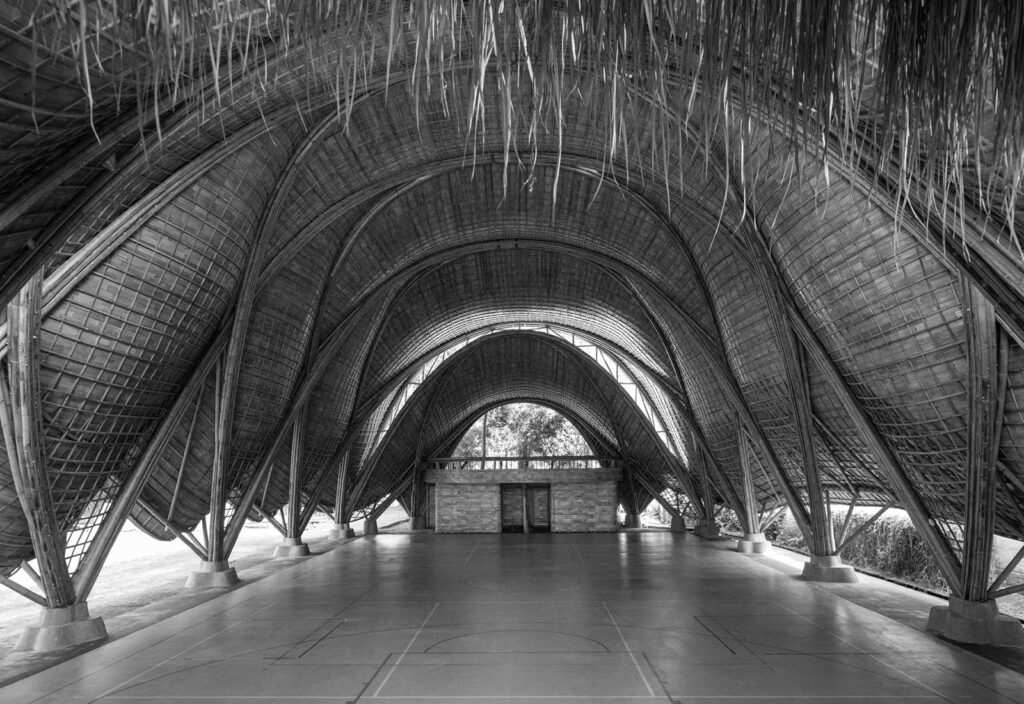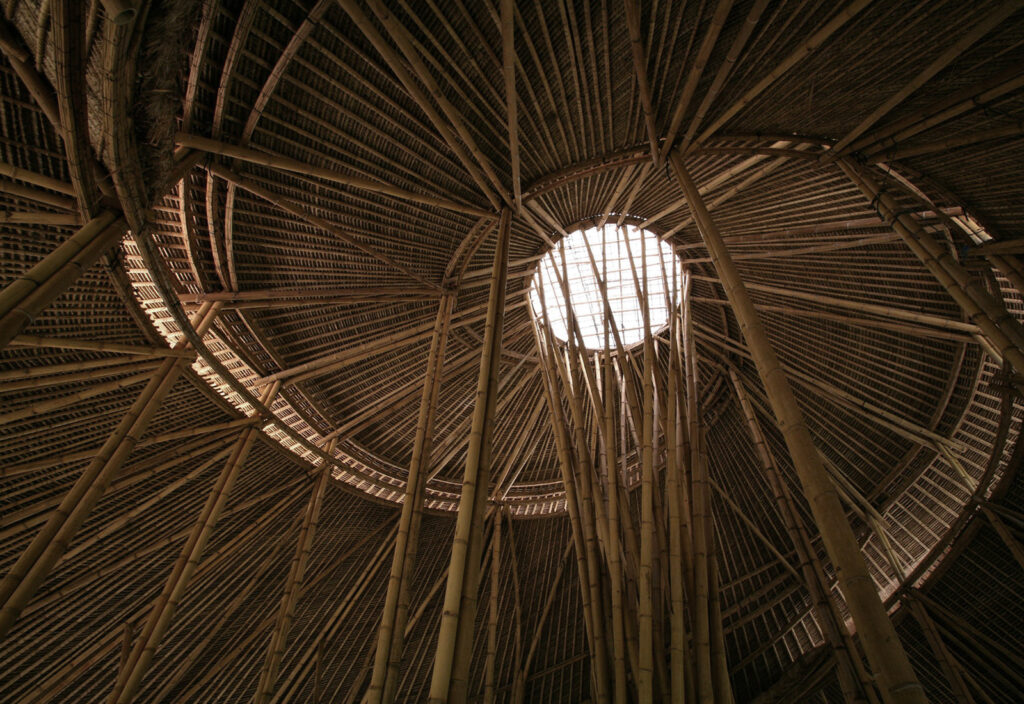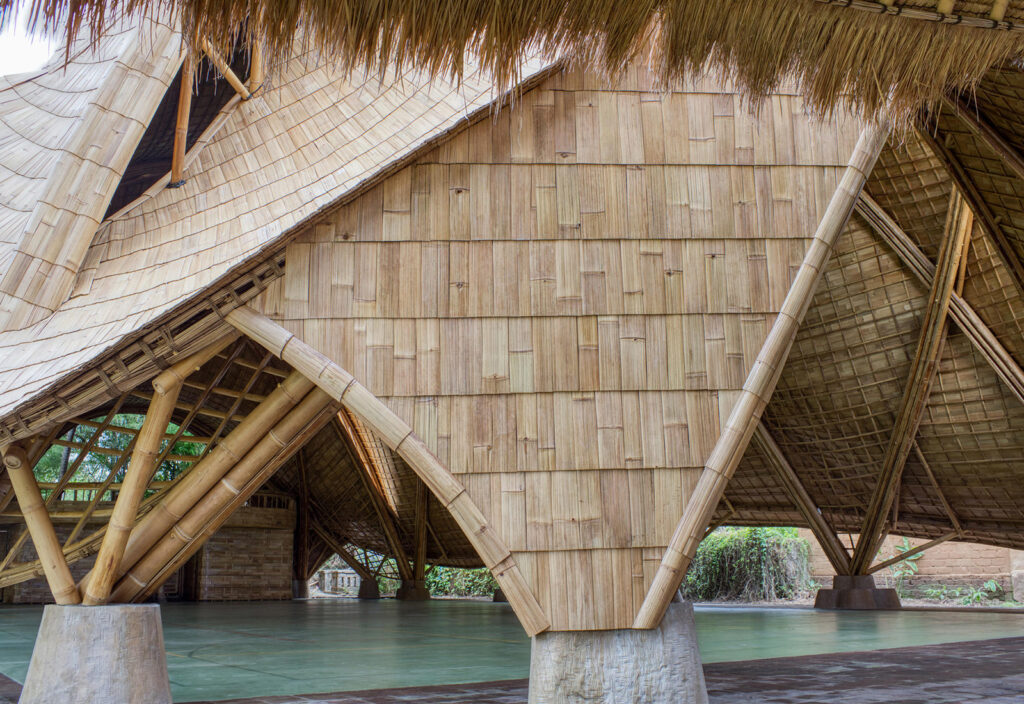
THE PUNCH RESOURCES
The Power of Bamboo
in Architecture & Construction
Bamboo is a fast-growing, woody grass known for its versatility and diverse applications. With over 1,400 species, it thrives in climates ranging from tropical to temperate regions. Due to its renewability and low environmental impact, bamboo has gained popularity in sustainable practices, distinguishing itself from less eco-friendly materials.
In the realms of architecture and construction, bamboo has emerged as a versatile and sustainable material, offering numerous advantages. Its rapid growth, renewability, and strength make it a preferred choice for eco-conscious designers and builders.
In Indonesia, the bamboo market is poised for substantial growth, with an expected compound annual growth rate of 6.2% from 2021 to 2028, reaching USD 2.8 billion by 2028. The construction sector leads this market, accounting for over 42.03% share in 2020. This trend is driven by the increasing commitment of government entities and construction companies to reduce carbon dioxide emissions from the industry.
Bamboo’s structural integrity, comparable to hardwood, positions it as an ideal choice for various architectural elements, including structural frameworks, flooring, and cladding. Beyond its strength, bamboo’s aesthetic appeal and design versatility have garnered widespread appreciation. As a renewable resource, bamboo stands as a symbol of sustainability, maturing in just a few years compared to the decades or centuries required for traditional building materials. Additionally, bamboo’s capacity to sequester carbon during its growth further enhances its eco-friendly reputation. Its application in sustainable architecture and construction serves as evidence of its potential to reshape the future of the built environment while mitigating the ecological footprint.
HOW DOES BAMBOO PERFORM IN THE CONSTRUCTION OF BUILDINGS?
Bamboo is renowned for its impressive mechanical properties, often surpassing traditional materials such as wood and steel. Its tensile strength rivals that of steel, and it can withstand compression better than concrete.
Additionally, bamboo’s outstanding flexibility enables it to bend without breaking, making it resilient against severe weather conditions, including earthquakes, hurricanes, and heavy snowfall. This characteristic makes it an excellent choice for regions prone to earthquakes or for structures requiring elasticity. Its lightweight composition makes it less vulnerable to damage from strong winds, and its robust load-bearing capacity can efficiently support substantial snow loads.
The durability of bamboo, however, depends on appropriate treatment, regular maintenance, and thoughtful design. When properly treated and shielded from moisture and insects, bamboo can last for decades, with some structures lasting over a century.
By incorporating bamboo alongside other materials and considering thoughtful design, its longevity can be further enhanced, underscoring its reputation as a sustainable and robust building resource.

Certain Bamboo Species can grow up to 91 cm in a day, Making it one of the Fastest-Growing Plants on Earth.
WHAT MAKES BAMBOO A SUSTAINABLE MATERIAL?
Bamboo is considered sustainable for several reasons. It can be harvested without killing the plant, as it regenerates from its roots. This allows for continuous harvesting without the need for replanting, contributing to its sustainability. Certain bamboo species can grow up to 91 cm (36 inches) in a day, making it one of the fastest-growing plants on Earth. This rapid growth ensures a quick and efficient resource renewal cycle.
Additionally, bamboo requires minimal water and no pesticides for cultivation. With natural pest-resistant properties, bamboo reduces the need for chemical pesticides during cultivation. Its extensive root system helps prevent soil erosion, and it can thrive in diverse climates, further reducing the environmental impact of its cultivation, making it well-suited for various geographic regions.
Bamboo’s sustainability is also attributed to its versatility. It can be used in various applications, from construction and furniture to textiles and paper. When harvested responsibly, bamboo stands as an eco-friendly alternative, promoting biodiversity and supporting sustainable practices.

HOW CAN ARCHITECTS AND INTERIOR DESIGNERS SEAMLESSLY INTEGRATE BAMBOO INTO THEIR WORK?
EDUCATION
Professionals should educate themselves on the properties of bamboo, various treatment methods, and construction techniques. This knowledge will enable them to make informed decisions about the use of bamboo in their projects.
COLLABORATION
Working closely with bamboo suppliers and specialists is essential to ensure the correct sourcing, treatment, and application of bamboo materials. These partnerships help maintain the integrity of bamboo throughout the design and construction process.
EXPLORATION
Designers and architects can experiment with bamboo as either a primary or complementary material. By understanding its unique properties and aesthetics, they can leverage bamboo’s versatility to achieve the desired outcomes in their projects.
ADVOCACY
Professionals can also play a crucial role in advocating for the development of standardized guidelines and regulations for bamboo construction. This support fosters a more robust and sustainable bamboo industry, benefiting both the environment and the architectural and design sectors.

Caste Study:
The Green School Arc by IBUKU
In the scenic landscape of Bali, Indonesia, where the Green School has long been a pioneer in innovative education, a remarkable new building rises—the Arc. The latest addition to the Green School campus goes beyond traditional limits, not just redefining bamboo architecture but also setting a groundbreaking standard for lightweight structures globally.
Behind this revolutionary structure is IBUKU, a design entity consistently exploring uncharted territories. The creation of the Arc marks a significant milestone in their journey, pushing the boundaries of what is possible in sustainable architecture.
A MILESTONE FOR SUSTAINABLE EDUCATION
The Green School, known for its twelve-year legacy of challenging norms and broadening perspectives, once again raises the bar with the Arc. This unique building isn’t just a physical space but a testament to the school’s commitment to global sustainable education. As the first of its kind, the Arc is a symphony of intersecting bamboo arches, each standing at an impressive 14 meters and spanning 19 meters. What sets it apart is the intricate network of anticlastic gridshells, ingeniously interconnecting the arches and deriving strength from their dual-curvature design.
INNOVATIVE ENGINEERING & ELEGANT DESIGN
The realization of the Arc required months of meticulous research, development, and fine-tuning of tailor-made details. The result is a refined design that seamlessly blends beauty with structural integrity. IBUKU’s dedication to expanding horizons in architecture and design is evident in every aspect of this engineering marvel.
NATURE’S BLUEPRINT: A SOURCE OF INSPIRATION
The inspiration for the Arc draws from one of nature’s ingenious strategies—the human ribcage. Much like the ribs in a ribcage work in compression, the arches of the Arc are held in place by tensioned anticlastic gridshells. This innovative approach not only creates a visually stunning effect, with gridshells seemingly draping across impossibly thin arches but also mirrors the efficiency found in nature’s design.
The counterintuitive orchestration of geometry within the Arc brings the structure into a state of equilibrium, reducing the need for excessive structural material. This not only adds to the aesthetic allure but also results in an unprecedented inner volume, showcasing the marriage of impossibly thin architecture and a lack of distracting trusses.
To put it simply, The Green School Arc by IBUKU showcases a remarkable blend of sustainability, innovation, and elegant architecture. As it adorns the Green School campus, it envisions a future where educational spaces harmoniously connect with the natural environment, establishing a fresh benchmark for the potential unlocked by sustainable design.
Explore the World
of Bamboo with Bamboo U Bali
An educational venture blossoming from the epicenter of the world’s bamboo building movement in Bali, Indonesia, Bamboo U invites enthusiasts to delve into the realm of bamboo craftsmanship. In partnership with the distinguished design firm IBUKU and conveniently situated a mere two minutes from the all-bamboo campus at Green School, Bamboo U boasts over a decade of pioneering experience in bamboo architecture.
This institution is a guiding light for sharing comprehensive insights into bamboo design and sustainable architecture. Having recently transitioned our bamboo courses into the digital sphere, we continue to build the bridge between imaginative innovation, eco-conscious construction, and the art of bamboo design.
Bamboo U stands ready to propel the bamboo movement forward, offering individuals the knowledge and skills necessary to craft their own bamboo structures. Aspiring learners are encouraged to join us on this educational journey, where the versatile potential of bamboo unfolds, contributing to a sustainable and innovative future.
EXPLORE THE PUNCH

